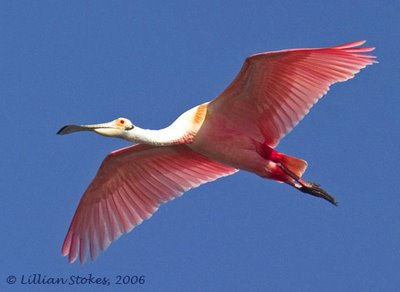Christmas Bird Counts are coming up, from Roseate Spoonbills in Florida
to Ravens in Alaska, all the birds will be counted.
It's a busy, busy time for everyone right now, but don't forget the Christmas Bird Counts are about to happen. That's where birders from an area (the country is divided into 15 mile diameter count circles, each with its own count date, usually in Dec.) go out and count all the birds in that area during a 24 hr. period. To participate by joining a search party or staying (warm) at home and counting birds at your feeders, click here.
The census data, while obviously affected by how many people participate from year to year, and whether new count circles are added, etc., is still very valuable. It gives a sense of the status and distribution of early winter bird populations across the whole country.
We have participating in the CBC, wherever we have lived, for just about as long as we have been birding. One of the things we like best is that on that special day, every bird counts, no matter what species it is. All birds are censused, so each is sought after. Just staying out all day and seeing what birds are around and what they are doing is special, something most people rarely do. We so enjoy the camraderie of the people we join with in our search party, as we go about our group effort to find every bird we can.
Every year is different. This year should be exciting because there are so many irruptive species that have come down into the U.S. How many Common Redpolls, Evening Grosbeaks, Pine Grosbeaks, Pine Siskins, Red-breasted Nuthatches, Northen Shrikes and other irruptives will be found? We will be counting in the Sanibel-Captiva, FL, Christmas Count this year and we will fill you in on how it goes.
Christmas Bird Count tips:
1. Keep your feeders full, watch in early am and mid-afternoon, times when birds feed heavily at feeders.
2. Count the maximum number of a species you have in view at one time, in one place, to avoid duplicate counting. Use binoculars. Bring a scope, if you are counting in wide open areas, it will help you see farther.
3. Chickadees in a flock fly across an open space one at a time. So wait for a chickadee flock you are watching to cross an open space, it will give you a more accurate count.
4. Watch carefully for other birds who hang out with chickadees in a "mixed flock". You may see a Brown Creeper, or kinglets.
5. Dress warmly, or cooly, depending on where you are. It's no fun to count if you're too cold or too hot.
6. Bring, or stop for snacks, (granola bars, coffee, hot cocoa in the North, cool water and sun block in the South) to keep you energized.
2. Count the maximum number of a species you have in view at one time, in one place, to avoid duplicate counting. Use binoculars. Bring a scope, if you are counting in wide open areas, it will help you see farther.
3. Chickadees in a flock fly across an open space one at a time. So wait for a chickadee flock you are watching to cross an open space, it will give you a more accurate count.
4. Watch carefully for other birds who hang out with chickadees in a "mixed flock". You may see a Brown Creeper, or kinglets.
5. Dress warmly, or cooly, depending on where you are. It's no fun to count if you're too cold or too hot.
6. Bring, or stop for snacks, (granola bars, coffee, hot cocoa in the North, cool water and sun block in the South) to keep you energized.
7. Bring our new, national, The Stokes Field Guide to the Birds of North America, which has all the plumages of the birds you will be seeing, and complete ID info.
8. Listen to our Stokes Field Guide to Bird Song CDs, eastern or western regions, beforehand, to help you ID birds by sound you will be finding.
9. Have fun!
10. Tell us about your own CBC if you participate in one. For more information on how you can join a Christmas Bird Count in your area go here.
9. Have fun!
10. Tell us about your own CBC if you participate in one. For more information on how you can join a Christmas Bird Count in your area go here.



3 comments:
Great tips. A tip in the colder regions is to find the open water. It's very important in areas that freeze.
I lead the Long Branch, NJ CBC which has a great variety of habitats including the ocean, lakes, rivers, and lots of woods. We typically tally on average 120-125 species. Sadly, I have to miss my own count this year because we're moving that weekend.
Patrick,
Like the tip about finding open water! too bad you have to miss your CBC, hope you have a good one next year!
Just started birding and I love it! I'm from South South Texas almost Mexico and we have tons of parrots in the evening! Love you blog! I posted a few pictures of some birds on my blog about a month ago! And we love them!
Post a Comment
Note: Only a member of this blog may post a comment.